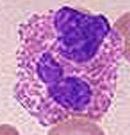

MedFriendly®


Eosinophil (Low and High Levels)
An eosinophil is a type of white blood cell present in the
blood. White blood cells help protect the body against
diseases and fight infections. Eosinophils help protect the
body against disease and infections by moving around and
eating some types of bacteria, foreign substances, and
other cells. They are very helpful in defending the body
against parasites. A parasite is any organism that lives in or
on another living being, gains an advantage by doing so, but
causes disadvantage to the being it is living on.
WHAT ARE SOME OTHER CHARACTERISTICS OF
EOSINOPHILS?
An eosinophil under the
microscope.
A main characteristic of eosinophils is that they have two round sections within them
called lobes. This can be seen in the picture of an eosinophil below. Sometimes, there is
a third section that is found on the connecting strand of thread-like bodies known as
chromatin.
The nuclei of eosinophils come in various forms. The word "nuclei" means more than
one nucleus. A nucleus is the center of a cell. Thus, the centers of eosinophils appear in
various forms.
Another characteristic of eosinophils is that
their cytoplasm (a gel-like substance that fills up
a cell) is mostly made of many large, rough-
looking, grain-like particles that scatter light.
These grain-like particles can be seen under
the microscope and mostly look alike. The
grain-like particles become stained a yellow-red
or orange color when exposed to a dye known
as eosin. This is why they are called
eosinophils. Dyes are colored stains that are
used in laboratories, often to tell cells apart
from one another.
WHAT PERCENT OF WHITE BLOOD CELLS ARE EOSINOPHILS?
Approximately 1% to 4% of white blood cells are eosinophils. This is the normal range
of eosinophils on bloodwork tests.
WHAT CAN CAUSE THE LEVEL OF EOSINOPHILS TO BE TOO HIGH?
The level of eosinophils can be too high (known as eosinophilia) in response to allergies. They can also
be too high when exposed to certain types of bacteria or parasites. A parasite is any organism that
lives in or on another living being, gains an advantage by doing so, but causes disadvantage to the
being it is living on. Certain types of skin disorders such as pemphigus can cause an increase in
eosinophils. Pemphigus is a severe skin disorder in which thin-walled blisters on the skin pop and leave
raw patches.
Certain types of medications can cause eosinophils to be too high. Eosinophils can also be high in
diseases that cause an increase in myeloid tissue. Myeloid tissue is a type of bone marrow (a tissue
found inside bones) that has many fibers. One such condition in which there is an increase in myeloid
tissue is polycythemia vera. Polycythemia vera is a condition of unknown cause in which there is a
long-term increase in red blood cells and other types of cells. Another such condition is myelofibrosis, in
which the normal bone marrow is replaced by fibrous tissue (the connective tissue of the body).
Increases in eosinophils are also seen in response to collagen vascular disorders. Collagen vascular
disorders are a group of acquired disorders that have in common widespread inflammation in blood
vessels and connective tissue. Eosinophilic gastroenteritis can also cause the eosinophil level to be
too high. Eosinophilic gastroenteritis is a condition in which eosinophils of the blood pass into the
mucous membranes of the small intestine. A mucous membrane is one of four major types of thin sheets
of tissue that line or cover various parts of the body. The intestine is a tube shaped structure that is
part of the digestive tract. It stretches from an opening in the stomach to the anus (rear end) and
occupies most of the lower parts of the belly. The intestine is divided into two main sections: the small
intestine and the large intestine.
Another condition that can cause a rise in eosinophils is sarcoidosis. Sarcoidosis is a condition in
which small, rounded bumps form on tissues. The bumps can form in many places on or in the body such
as the skin or the lungs. Loffler's syndrome can also cause an increase in eosinophils. Loffler's
syndrome is a disorder in which fever, weight loss and breathlessness occur, in addition to substances
penetrating the lungs, accompanied by blood. An increase in eosinophils is also seen in Addison's
disease. Addison's disease is a life-threatening condition in which there is a complete or partial failure
of the adrenal cortex. The adrenal cortex is the outer part of an important organ (the adrenal gland) that
produces hormones that are essential for the body to regulate itself. Hormones are natural chemicals
produced by the body and released into the blood that have a specific effect on tissues in the body.
WHAT CAN CAUSE THE LEVEL OF EOSINOPHILS TO BE TOO LOW?
A low eosinophil level is usually not a cause for concern and is actually quite common. Eosinophils can
be too low due to administration of steroids. Steroids are any of a large number of hormone substances
with a similar and basic chemical structure. Hormones are natural chemicals produced by the body and
released into the blood that have a specific effect on tissues in the body.
WHAT ELSE ARE EOSINOPHILS CALLED?
Eosinophils are also known as eosinophilic leukocytes, acidophilic leukocytes, eosinophiles, oxyphiles,
oxyphilic leukocytes, and oxyphils.
WHAT IS THE ORIGIN OF THE TERM "EOSINOPHIL"?
Eosinophil comes from the Greek word "eos" meaning "dawn," and the Greek word "philein" meaning "to
love." Put the two words together and you have "to love dawn." Eosinophils become stained when
exposed to a dye known as eosin. This is why they are called eosinophils.
















